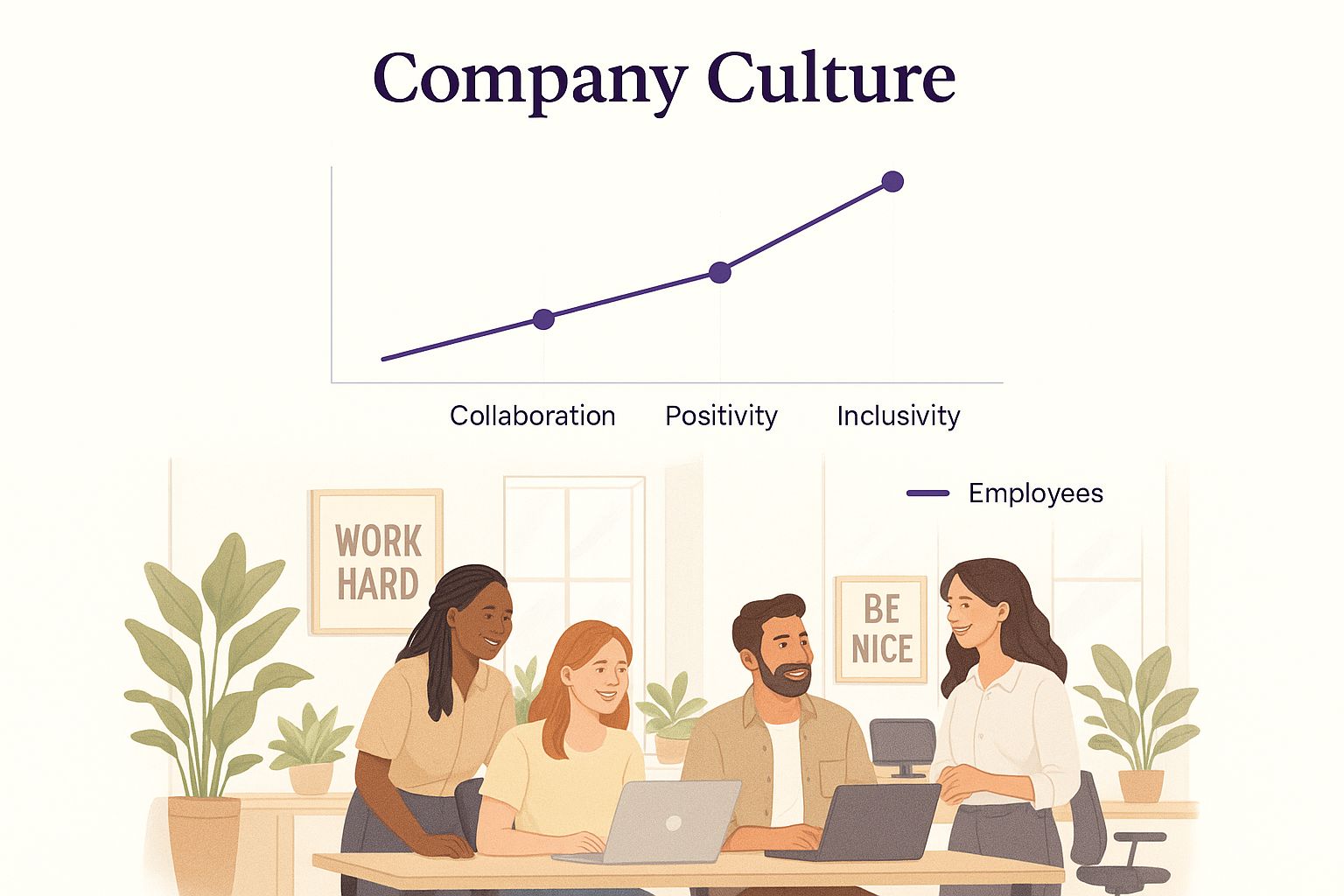The State of Employee Retention: What's Really Happening
Organizations face a significant challenge: retaining their employees. This isn't a new problem; the struggle to improve employee retention has been ongoing. This section explores the current realities companies face, drawing on data and insights from HR professionals. We'll look at how changing employee expectations, economic shifts, and increased job availability have reshaped the retention landscape.
Understanding the Factors Driving Employee Turnover
Why do employees leave? The reasons are complex. While compensation remains a factor, it’s not the whole picture. Organizational trust, a positive culture, and growth opportunities are crucial.
A toxic work environment, for example, can push even well-paid employees to seek new jobs. Also, a lack of clear career progression can leave employees feeling stuck, prompting them to search for advancement elsewhere. Understanding how to retain employees is key.
For more information, check out proven customer retention strategies. While customer-focused, these principles offer helpful parallels for understanding employee loyalty.
Factors like organizational confidence, cultural satisfaction, and compensation all impact employee retention. The Eagle Hill Consulting Employee Retention Index showed a 6.2-point drop to 98.5 in early 2025.
This drop correlates with declining organizational confidence, culture ratings, and compensation satisfaction. A strong job market also empowers employees to explore other roles, potentially leading to higher turnover. Addressing these issues proactively is essential to retain talent and reduce turnover risks. You can find more detailed statistics here.
Measuring Retention: Beyond the Basics
Standard retention metrics, such as overall turnover rate, can be deceptive. They offer a broad view, but they don't tell the whole story. Focusing only on these numbers can mask critical issues.
A high turnover rate in one department, for instance, could point to a local management problem rather than a company-wide one.
The Importance of Proactive Retention Strategies
Reactive retention strategies, implemented after employees begin leaving, are often too little, too late. Organizations need proactive measures that address the root causes of turnover before it escalates.
This requires a shift from reacting to departures to actively building a workplace where employees want to stay. Creating a strong culture, investing in career development, and offering competitive compensation are all key parts of this proactive approach. This fosters a more engaged, productive, and stable workforce.
The True Cost of Losing Your People: Beyond the Numbers
Losing an employee is a costly affair, far exceeding the immediate expense of finding a replacement. This isn't just about the visible costs like recruitment; it's about the hidden financial drain that impacts your entire organization. Let's explore the complete picture of employee departures, from the obvious expenses to the less apparent, but equally damaging, losses in productivity and team cohesion.
The Financial Ripple Effect of Turnover
The upfront costs of replacing someone – advertising the position, paying recruiting agencies, and onboarding new hires – are certainly substantial. But the indirect costs, often harder to quantify, frequently overshadow these initial expenses.
- Loss of Institutional Knowledge: When employees leave, they take valuable expertise and experience. This knowledge gap can hinder projects and disrupt team performance.
- Disrupted Team Dynamics: Losing a team member impacts morale and productivity as remaining employees adjust to new workflows and responsibilities.
- Strained Client Relationships: If the departing employee managed key client accounts, their absence can jeopardize these relationships and potentially lead to lost business opportunities.

This infographic portrays a dynamic and collaborative office setting, representing the positive influence of a thriving company culture on employee retention. It captures the sense of energy and connection that flourishes in a supportive and stimulating workspace. The image reinforces the importance of fostering a positive environment to retain valuable talent.
Calculating Your Turnover Costs: A Practical Framework
Understanding the financial and strategic ramifications of employee turnover is critical for successful retention. Each departing employee costs approximately one-third of their annual salary. Businesses grappling with high turnover experience 23% less profitability than those with effective retention programs. This financial impact underscores the need for robust retention strategies, especially considering the current challenges in employee retention. Annual quit levels remain high, with 47.5 million in 2021 and 50.5 million in 2022. This emphasizes the importance of identifying and addressing the root causes of turnover. More detailed statistics can be found here.
To calculate the true cost of turnover, you need a structured approach. This involves evaluating both direct and indirect costs. Direct costs encompass the tangible expenses tied to recruitment, such as advertising and onboarding. Indirect costs, often harder to measure, include lost productivity, diminished team morale, and the negative impact on client relationships.
To help visualize these costs, let's look at a breakdown:
The True Cost of Employee Turnover: This table breaks down the average costs associated with losing employees at different organizational levels
| Position Level | Direct Costs | Indirect Costs | Total Replacement Cost (% of Annual Salary) |
|---|---|---|---|
| Entry-Level | Recruitment fees, onboarding | Lost productivity during training, impact on team workload | 30-50% |
| Mid-Level | Recruitment fees, onboarding, training | Lost productivity, project delays, knowledge gap | 100-150% |
| Senior-Level | Executive search fees, onboarding, training | Significant knowledge loss, leadership vacuum, impact on strategy | 200-250% |
As this table illustrates, the costs escalate significantly as the position level increases, reflecting the greater investment in higher-level employees and the more significant impact of their departure.
Making the Business Case for Retention
With a clear understanding of your turnover costs, you can build a compelling case for investing in retention programs. By showcasing the financial burden of losing employees, you can secure executive buy-in for initiatives that prioritize employee retention. These initiatives can include programs focused on career development, improvements to workplace culture, and offering competitive compensation and benefits. Leading companies are quantifying previously “unmeasurable” impacts, like the loss of client relationships, to strengthen arguments for retention budgets. This data-driven approach helps organizations prioritize initiatives with the highest ROI for retaining their workforce. By highlighting the financial benefits of investing in employees, organizations can justify the resources allocated to creating a supportive work environment that fosters loyalty and promotes long-term growth.
Career Development That Actually Makes People Stay

Forget generic training programs. Today's successful organizations understand that effective career development is key to retaining their top talent. It's not about occasional workshops; it's about creating clear, achievable career paths that motivate employees and align with company objectives. This requires a shift away from a one-size-fits-all model to a more personalized approach that fosters individual growth.
Personalized Development Plans: Investing in Individual Growth
Effective career development begins with understanding each employee's aspirations. This involves open communication and a dedicated effort to create personalized plans.
These plans should outline specific skills to develop, experiences to gain, and milestones to reach. For instance, a marketing associate aiming for a management role might focus on leadership training, project management experience, and public speaking opportunities. A well-defined plan provides employees with a clear roadmap for their future within the company.
Mentorship Programs That Foster Growth and Connection
Well-implemented mentorship programs can significantly improve employee retention. Pairing employees with experienced mentors offers invaluable guidance and support. These relationships foster a sense of belonging and provide a safe environment for employees to discuss challenges and seek advice.
Mentors can also help mentees navigate company culture and identify advancement opportunities. This creates a more supportive and engaging work environment, making employees less likely to leave. Mentorship programs build a supportive network that encourages both professional and personal development.
Internal Mobility: Keeping Ambition In-House
Offering internal mobility opportunities is crucial for retaining ambitious employees. This allows individuals to explore different roles and departments within the company, expanding their skills and experience. For example, a sales employee might discover a passion for product development through an internal transfer.
This approach not only retains valuable talent but also builds a more versatile and adaptable workforce. It demonstrates to employees that the company values their growth and invests in their future, strengthening their commitment and loyalty.
Measuring ROI and Scaling Your Efforts
Investing in employee career development is directly linked to improved employee retention. LinkedIn Learning reports that 93% of employees are more likely to stay with an organization that invests in their career development. This highlights the importance of dedicating resources to continuous learning and growth opportunities.
This fosters a culture of development and satisfaction, resulting in higher retention. Furthermore, companies with high retention rates enjoy benefits such as increased profitability and improved customer satisfaction. Gallup reports that organizations with strong retention experience a 22% increase in overall profitability. This underscores the financial benefits of prioritizing employee development and satisfaction. Discover additional insights on employee retention statistics.
How can you measure the effectiveness of your career development initiatives? Start by tracking key metrics such as employee satisfaction, internal promotion rates, and, of course, retention rates. Also, gather employee feedback on their development experiences to identify areas for improvement.
These insights will help refine your programs and ensure they contribute to employee growth and retention. By showcasing the tangible benefits of these initiatives, you can justify continued investment and expand their reach throughout the organization, regardless of its size or budget. Remember, investing in career development isn't an expense; it's a strategic investment in your organization's future.
Building a Workplace Culture People Won't Want to Leave
Beyond the ping pong tables and free snacks, what truly makes employees want to stay? This section explores the core elements of retention-focused cultures, using insights from organizations that have successfully transformed their employee experience. We'll examine practical strategies for cultivating psychological safety, establishing meaningful recognition programs, and fostering inclusive environments where diverse talent thrives.
Psychological Safety: Fostering Open Communication and Trust
Creating a workplace where employees feel safe to express opinions, share ideas, and even admit mistakes is crucial for retention. This psychological safety fosters open communication, encourages innovation, and builds stronger teamwork. When employees feel they can speak up without fear, they're more engaged and invested in their work. This sense of security and belonging significantly influences their decision to stay. For example, a team that embraces open feedback can quickly identify and address problems, improving performance and job satisfaction.
Recognition Systems: Showing Appreciation That Truly Matters
Traditional "Employee of the Month" awards often miss the mark. Meaningful recognition should be timely, specific, and tied to individual contributions. This could involve acknowledging a team member's project success, praising their problem-solving skills, or recognizing their extra effort in helping a colleague.
Consider peer-to-peer recognition programs where colleagues acknowledge each other’s accomplishments, amplifying the impact of appreciation. This fosters a more positive and supportive environment where employees feel valued and motivated. Platforms like Happily.ai provide tools for real-time feedback and peer recognition, contributing to a more positive and engaging work environment.
Inclusion and Diversity: Creating a Sense of Belonging
An inclusive workplace celebrates diversity and makes everyone feel welcome and respected. This goes beyond simply hiring diverse talent; it means fostering a culture of belonging where everyone feels comfortable being themselves and sharing their unique perspectives. Diversity and inclusion training, mentorship programs, and employee resource groups can achieve this. These initiatives create community and support, making employees feel valued for who they are.
Identifying and Addressing Cultural Blind Spots
Many organizations unintentionally have cultural blind spots that contribute to turnover. These might include a lack of transparency in decisions, insufficient growth opportunities, or a disconnect between stated values and actual practices. Identifying these blind spots requires honest self-assessment and listening to employee feedback. Anonymous surveys and focus groups can provide valuable insights into areas needing improvement.
Targeted initiatives can then address specific challenges, creating a more positive and supportive environment. This proactive approach builds trust and demonstrates a commitment to continuous improvement. Happily.ai can help gather real-time feedback, allowing companies to address emerging cultural issues before they escalate.
Measuring Cultural Health and Involving Employees
Traditional engagement surveys offer some information, but understanding cultural health requires a more holistic approach. Leading companies are moving beyond annual surveys to gather frequent feedback through pulse surveys and informal check-ins. They're actively involving employees in shaping cultural development, recognizing employees are the best source of information on what needs to change. This collaborative approach fosters ownership and empowers employees to create a better work environment.
This ongoing dialogue and continuous feedback enable data-driven decisions and a workplace culture that truly supports employee well-being and long-term retention. By involving employees, organizations ensure their initiatives align with workforce needs and aspirations, creating a more positive and engaging experience.
To understand the crucial elements of employee retention, let's look at the following table. It breaks down the impact, difficulty, and potential ROI of several key factors.
Employee Retention Factors: What Really Matters This table compares the relative impact of different factors on employee retention rates based on research studies.
| Retention Factor | Impact Level (1-10) | Implementation Difficulty (1-10) | ROI Potential |
|---|---|---|---|
| Psychological Safety | 9 | 6 | High |
| Meaningful Recognition | 8 | 4 | High |
| Inclusive Environment | 9 | 7 | High |
| Addressing Cultural Blind Spots | 7 | 5 | Medium |
| Measuring Cultural Health | 6 | 3 | Medium |
As the table highlights, fostering psychological safety and an inclusive environment are high-impact factors, though they can be moderately challenging to implement. Meaningful recognition programs are also impactful with relatively lower implementation difficulty. Addressing blind spots and measuring cultural health offer good returns with moderate effort. Investing in these key areas can significantly impact long-term employee retention.
Compensation Strategies That Work (Without Breaking the Bank)
Attracting and retaining top talent is a crucial goal for any organization. However, it doesn't always require substantial salary increases. Savvy organizations are discovering creative ways to develop compensation packages that appeal to employees without exceeding budget constraints. This involves understanding what employees truly value. It also means designing a total rewards approach that meets those needs.
Benchmarking and Pay Transparency: Building Trust and Fairness
Compensation benchmarking is a vital step in creating a competitive compensation strategy. This process involves researching industry standards. It also includes comparing your current salary offerings to ensure they align with the market. This data informs decisions about salary adjustments and ensures your compensation stays competitive.
HR teams can strengthen this process by using a salary benchmarking tool like HR Datahub. Access to live market pay data helps managers make evidence-based decisions and ensures consistency across reviews. The result is greater confidence in pay policies and a stronger foundation for retention strategies.
Pay transparency, where salary ranges are openly communicated, is gaining popularity as a valuable retention tool. This approach fosters trust and demonstrates a commitment to fair compensation. When employees understand how their pay is determined, it can reduce feelings of being undervalued and minimize suspicions of inequities.
Benefits That Matter: Recognizing Diverse Employee Needs
Beyond base salary, benefits play a crucial role in employee satisfaction and retention. While traditional benefits like health insurance and retirement plans are still important, organizations are also exploring additional options. These can include flexible work arrangements, professional development opportunities, student loan repayment assistance, or even pet insurance.
Offering a diverse benefits package that caters to the varied needs of your workforce is key. Younger employees might prioritize student loan assistance, while parents might value flexible work arrangements. Understanding your employees’ demographics and preferences is essential for designing a benefits package that truly resonates.
Emerging Compensation Trends: Flexibility and Creativity
The working world is constantly evolving, and compensation strategies must adapt accordingly. Flexible pay structures, where employees have some control over their pay frequency, are becoming increasingly common. This empowers employees to better manage their finances and addresses the growing need for financial wellness support.
In addition to traditional benefits, organizations are exploring unique perks that can boost retention. These might include on-site childcare, gym memberships, catered lunches, or company-sponsored social events. While seemingly small, these perks can have a significant impact on employee morale and contribute to a more positive work environment. For remote employees, staying motivated is especially important. Here are some tips on how to stay motivated working from home.
Communicating Total Value: Beyond the Paycheck
Employees often don't fully understand the total value of their compensation. Effectively communicating this value is crucial, highlighting not only salary but also benefits, perks, and development opportunities. This can involve personalized total rewards statements that outline all aspects of compensation.
For instance, a statement could include the monetary value of health insurance, retirement contributions, and paid time off, in addition to base salary. This helps employees recognize the full scope of their compensation. It also helps them appreciate the company's investment in their well-being.
Segmenting Your Strategy: Addressing Generational Differences
Different generations often have varying priorities regarding compensation. Millennials and Gen Z may prioritize professional development and work-life balance. Baby Boomers, on the other hand, might prioritize retirement benefits.
Therefore, segmenting your compensation strategy and tailoring offerings to each generation's specific needs can be beneficial. This demonstrates an understanding of their unique priorities and creates a more compelling value proposition for all employees. This targeted approach can enhance appreciation and belonging across the workforce. By acknowledging the unique needs of each generation, organizations can create a more inclusive and rewarding environment for everyone.
Retention-Focused Leadership: It's Not What You Think
The hard truth is that employees often leave managers, not companies. This section explores leadership behaviors that encourage retention and those that drive talent away. We'll discover how successful organizations cultivate managers who retain top performers through valuable feedback, career guidance, and genuine recognition.
The Manager's Role in Retention
Managers significantly influence an employee's decision to stay or leave. A Gallup study found that managers can influence at least 75% of the reasons for voluntary turnover. This highlights the critical role of effective leadership in retaining valuable talent.
Developing strong leadership skills is essential for improving retention rates. Managers who prioritize open communication, provide regular feedback, and actively support their team's growth create a positive work environment. This environment fosters loyalty and engagement. This proactive approach can dramatically reduce turnover and improve overall team performance.
Effective Feedback and Coaching: Guiding Growth and Performance
Think of a sports team. Would a coach simply tell players to "play better"? No. They provide specific feedback, identify areas for improvement, and offer personalized guidance.
Similarly, managers should provide regular, specific, and actionable feedback. This isn't about criticism. It's about helping employees understand their strengths, identify areas for development, and achieve their full potential. This coaching approach builds trust and fosters a culture of continuous improvement.
Recognition That Resonates: Showing Genuine Appreciation
Authentic recognition goes beyond generic praise. It's about acknowledging individual contributions meaningfully. For example, instead of a blanket "good job," a manager might say, "I really appreciate how you handled that difficult client situation. Your calm demeanor and problem-solving skills were invaluable." This specific feedback demonstrates that the manager noticed and valued the employee's unique contribution.
Happily.ai can assist in facilitating peer-to-peer recognition, allowing team members to acknowledge each other's accomplishments. This strengthens team bonds and fosters a culture of appreciation, contributing significantly to a positive and supportive work environment.
Identifying Retention Risks: Proactive Intervention
Just as a doctor monitors vital signs for early warning signs of illness, managers should be attuned to potential retention risks within their teams.
Changes in behavior, decreased productivity, or expressions of dissatisfaction can indicate potential issues. Equipping managers with early intervention tools, such as regular check-ins and open communication channels, can help address these concerns before they escalate.
Accountability and Support: Creating a Retention-Focused System
Creating a culture of accountability for retention is crucial. This means holding managers responsible for their team's turnover rates and providing them with the resources and support they need to succeed.
This could involve leadership training programs focusing on retention strategies, access to data and analytics on team morale and engagement, and tools for providing effective feedback and recognition. This empowers managers to take ownership of retention within their teams. It creates a system where retaining talent is a shared responsibility.
Common Management Mistakes That Drive Turnover
Several common management missteps can accelerate employee turnover. These include:
- Lack of Communication: Failing to keep employees informed about important decisions and changes can create uncertainty and distrust.
- Micromanagement: Excessive control stifles creativity and autonomy, making employees feel undervalued and demotivated.
- Ignoring Employee Feedback: Failing to solicit or address employee feedback sends the message that their opinions don't matter.
- Inconsistent Recognition: Sporadic or unfair recognition can create resentment and a sense of inequity.
By addressing these common pitfalls, organizations can create a leadership culture that prioritizes employee well-being and fosters a supportive and engaging work environment. This proactive approach not only reduces turnover but also boosts morale, productivity, and overall team performance. Happily.ai provides resources and tools to help managers improve communication, offer consistent recognition, and gather valuable feedback from their teams, contributing to a more positive and engaging work environment.
Measuring What Matters: Retention Metrics That Drive Results
Stop guessing about how well your retention strategy is working. This section offers a framework for tracking the metrics that predict employee turnover and measure the success of your interventions. We'll move beyond simple turnover rates and explore how successful organizations distinguish between typical and problematic attrition. You'll learn how to use predictive analytics to identify potential retention risks and conduct insightful stay interviews. We'll also discuss practical approaches for establishing benchmarks, setting improvement goals, and effectively presenting retention data to leadership.
Beyond Turnover Rate: Understanding Attrition Nuances
While turnover rate is a basic metric, it’s crucial to understand the different types of attrition. Not all turnover is negative. For instance, if a consistently underperforming employee leaves, it opens an opportunity to hire someone more skilled.
However, losing high-performing employees is a serious problem. Differentiating between these forms of attrition paints a clearer picture of your retention situation. This deeper understanding helps you focus on keeping valuable talent. It also helps identify potential issues within specific teams or departments.
Predictive Analytics: Identifying Retention Risks Early
Predictive analytics can be a valuable resource for recognizing employees who might be thinking about leaving. By examining data like performance reviews, compensation history, and employee engagement survey responses, you can spot patterns that signal possible flight risks. For example, an employee with consistently subpar performance reviews and no salary increase in two years might be more likely to depart.
Early identification of these risks allows for proactive intervention. This could involve offering additional training, providing career development opportunities, or addressing underlying employee concerns. This proactive approach can significantly reduce turnover, saving your organization time and money.
Stay Interviews: Uncovering Actionable Insights
Stay interviews are structured discussions with current employees designed to understand why they stay with the company and what might cause them to leave. These interviews provide valuable insights into what’s working well and where you can improve. Unlike exit interviews, which focus on why employees are leaving, stay interviews offer the chance to address concerns and improve retention before employees begin searching for new jobs.
These conversations should occur in a safe, confidential setting where employees feel comfortable sharing honest feedback. Questions might include: What excites you about coming to work each day? What challenges are you facing? What could the company do to better support your career goals? Answers to these questions can uncover hidden retention risks and highlight areas for improvement.
Benchmarking and Goal Setting: Measuring Progress and Success
Establishing meaningful benchmarks is essential for tracking progress and evaluating the success of your retention initiatives. Compare your turnover rate and other retention metrics to industry averages and competitors' data to gauge your position. This helps identify areas for improvement and set realistic goals.
For example, if your turnover rate is substantially higher than the industry average, you know you need to concentrate on improving retention. Conversely, if your rate is lower, you can pinpoint what you’re doing right and continue those practices. Setting SMART goals (Specific, Measurable, Achievable, Relevant, and Time-Bound) will help you stay focused and make progress. A SMART goal could be to reduce turnover by 10% within the next year.
Communicating Retention Data: Making the Case for Investment
Effectively presenting retention data to executives is essential for gaining support and resources for your initiatives. Use clear visuals, such as charts and graphs, to show trends and highlight turnover’s impact on the organization. For instance, a chart correlating high turnover with decreased profitability can strongly advocate for investing in retention programs.
Focus on the return on investment (ROI) of retention initiatives. Show how reducing turnover increases productivity, lowers recruitment costs, and boosts employee morale. By demonstrating the tangible benefits of investing in retention, you can garner support for your efforts and create a more sustainable approach to keeping your valuable employees.
Ready to transform your workplace culture and significantly improve employee retention? Learn more about how Happily.ai can help.









